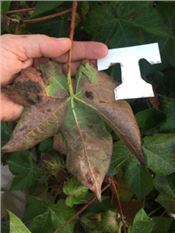Red Leaves In Cotton: Causes And Implications
DR. TYSON RAPER
JACKSON, TENN.
Observing canopy characteristics during the growing season is a good way to understand the plant’s response to its environment. Occasionally, portions of the canopy may develop reddish-purple or red tones. The synthesis of anthocyanin, the pigment which typically causes the reddening, is commonly increased after leaves are exposed to light following multiple abiotic and biotic stresses. Subsequently, anthocyanin may become visible at multiple times through the growing season. When leaf reddening appears late in the season, it commonly indicates a crop has been properly managed. However, leaf reddening occurring earlier in the growing season may indicate the crop has or is experiencing some type of stress. Producers should be vigilant in determining the cause of the stress and ameliorating it within the current season, if practically possible. Otherwise, causes such as nutrient deficiencies should be corrected before the following growing season.
Understanding the cause of a color shift in the canopy will guide input decisions and can therefore prevent unnecessary costs and/or increase yields. In an effort to describe this phenomenon, discuss possible causes for this shift, and explain what (if anything) should be done to correct it, we have recently published a short article entitled, ‘Red leaves in Cotton: Causes and Implications.’ This article can be accessed online at http://news.utcrops.com/wp-content/uploads/2016/07/W-344-Red-Leaves-in-Cotton.pdf . ∆
DR. TYSON RAPER: Cotton & Small Grains Specialist, University of Tennessee
